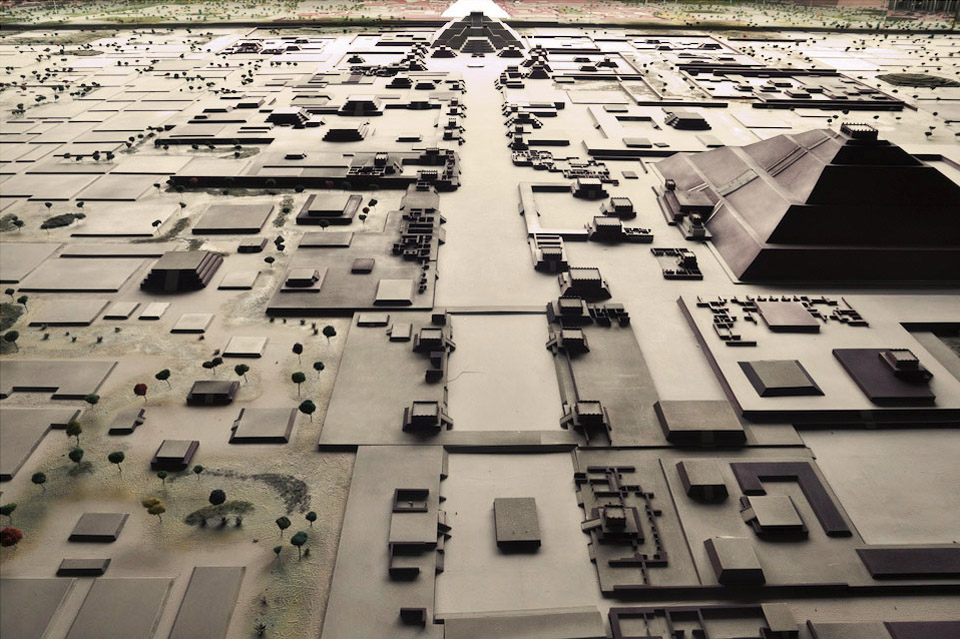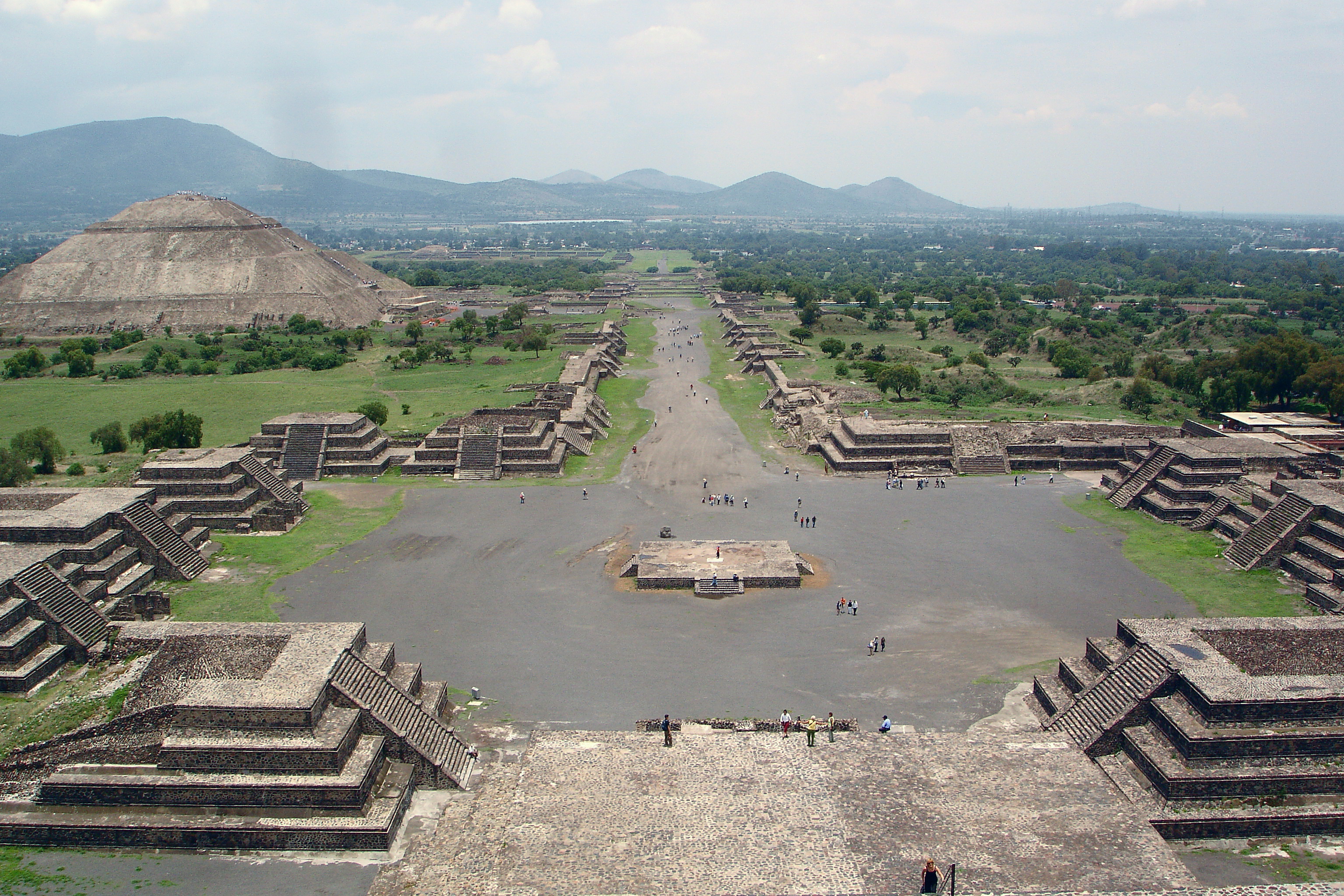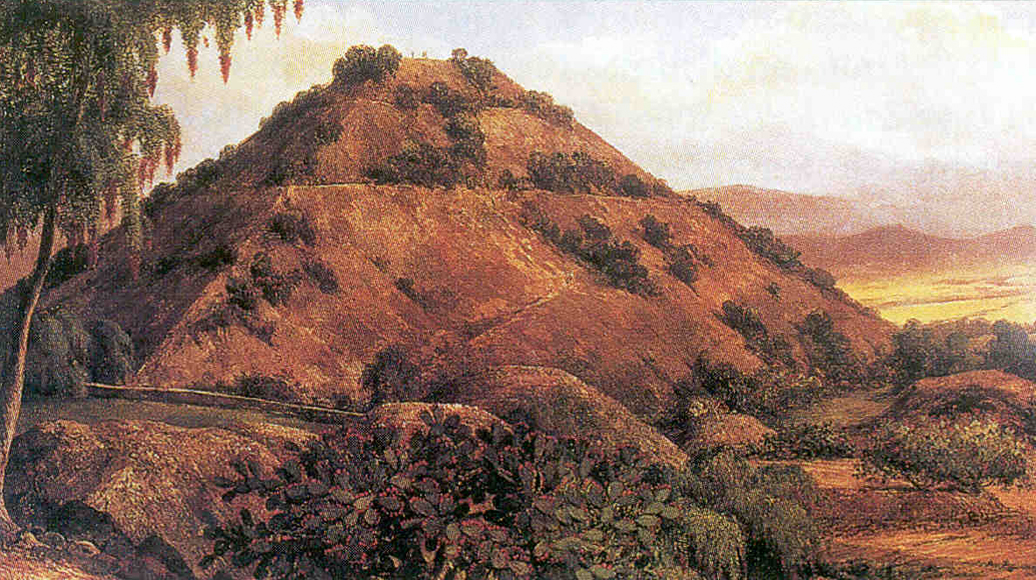The ascent to the top of the Pyramid of the Sun doesn’t seem so
difficult when you are at the bottom looking up, but once you start climbing
you realize the higher you go, the more steep the slope of the stairs becomes.
It gets so angled at a certain point that you actually have to use a rope that
is secured at the top of the pyramid that works all the way down to the bottom.
I just can’t seem to understand how people almost half my size were capable of
running up and down the stairs several times a day. In order to scale one of
the four sections of wide stairs lining the front of the pyramid, you have to
dedicate at least 10 minutes. As you move further along, you get more tired and
slower, and you really do feel out of breath because of the elevation, so to
get to the top it takes slightly more than half an hour.
Climbing stairs for us is as hassle enough today, and we even
have the luxury of side bars and big wide steps, but not at the Pyramid of the
Sun. The steps are roughly 5 to 8 inches apart from each other, and about a foot
high. There are people who work at the pyramid, who are solely focused on
teaching tourists how to correctly scale the massive monument. “Facing
sideways! Now Zigzag!,” yelled the tour guide. I only made it halfway up before
I started to feel defeated and intimidated, but thankfully my brother was there
to motivate me to the top.
Two years ago, I reached the top of the Pyramid of the Sun while
standing next to my brother Joseph. I could feel the heat of the sun beating
down on the back of my neck, I could see for miles and miles across the valley,
and the sheer size of it all was quite humbling. I doubt this gives me much
credibility in terms of my knowledge about the pyramid, so I also researched
online and came across a book called “Cities of Ancient America,” by Judson
Knight. It provided me with a basic understanding of the ancient city in which
the pyramid reside. I also consulted an article written by Martin Lloyd called,
“Getting Physical Inside a Pyramid,” which is about a group of Mexican
archaeologists from UNAM, whom are attempting to scan the great pyramid from
below; hopefully in order to better understand the mystery of the great and
ancient landmark.
D. Preview:
I will explain two basic things today which include: a brief history of the
city of Teotihuacan, which is where the pyramids reside among themselves; and a
more in depth look at what archaeologists already know and what they hope to
find during the upcoming years about the Pyramid of the Sun itself.
As is the same for the Great Pyramids in Egypt, a magnificent Pyramid is a
result of awesome internal stability in the government, and excellent
cooperation from every faction of society. I have prepared some background
information on the City of Teotihuacan.
The ancient
metropolis city of Teotihuacan can be located about an hour north of what is
now modern day Mexico City. It was built around 100A.D. and truly is the 1st
metropolis in the Western Hemisphere. According
to Martin Lloyd, the city of Teotihuacan was settled more than 2,000 years ago.
It was a well-organized and planned city that spanned roughly 8 square miles,
which is enormous for a city of that time. It’s peak
years were between 300C.E. and 600 C.E. It had a population
of roughly 250,000 people, which is incredible for a city at that time. If the
numbers are true, then that would have made Teotihuacan the 6th
largest city in the world at that time.
The
metropolis had trade routes that extended all the way through Mesoamerica
(partly that which makes up southern Mexico today) down to Guatemala, and
perhaps even a little farther. Archaeologists
still cannot figure out who or what type of government was in place during the
cities reign. Surprisingly not very much is known about the site, due to a
severe lack of artifacts and also the paint that was used to line the
limestone-covered walls has all disappeared with time.
The city was mainly comprised of
one long avenue, named “Avenue of the Dead,” by the Aztecs. It was lined with
pyramids of many different size and importance including a few famous ones.
Homes were spread out in proportional grids across the valley for miles, but
the most significant structure was, and still is, the Pyramid of the Sun.
Due
to the lack of evidence for supporting any one specific theory on the actual
creation, purpose, inner architecture, or demise of the pyramid, one can
encounter such a wide array of ideas that it’s hard to figure out what is true
and what is not. Here are some non-disputable facts to get us started. According
to Judson Knight, author of “Cities of Ancient America,” the Pyramid’s original
name is unknown. It is now called the Pyramid of the Sun, as was given the name
from the Aztec’s after they found the city having been abandoned for centuries. The pyramid is actually only one part of a much larger complex found in the middle
of the city and was constructed in 2 phases. The first phase started around
100C.E. and was then completed during the 2nd phase, which brought
the pyramid to a width of 738’ and a height of 216’, making it the 3rd
largest pyramid in the world, next to the Egyptian Pyramids at Giza.
It is
built on top of what is thought to be a man-made tunnel, which extends to a
large cave 6 meters directly underneath the center of the pyramid. Whether the
tunnel is natural or manmade is unknown; as is the actual purpose of the
tunnel. Alejandro Villalobos, a
physicist, and Arnulfo Martinez, an archaeologist, hail from the National
Autonomous University of Mexico(UNAM). The school is bankrolling a $500,000
project to assemble a powerful particle detector in the tunnel system
underneath the great pyramid with the goal of being able to map out the
interior of the Sun Pyramid, without having to move a single stone. The idea is
to basically get a giant CAT-SCAN of the interior in order to determine if
there are any hidden passageways, tunnels, tombs, catacombs, or other empty
spaces about the size of a TV or larger within the pyramid. If such places
exist, they will be our best chance at finding artifacts, skeletons, or any other precious evidence needed to help
shed some light on the mystery that seems to perpetually surround the pyramid
and city.
That being said, Teotihuacan
has survived the centuries with as much ease as it would take bear to
hibernate, and I’m sure that if given the opportunity, it could endure another
millennia or so. Even though our knowledge of the site is limited, all is not
lost. During the Dark Ages in Europe, people would look in awe and wonder at
the Coliseum, as they contemplated it’s mysterious history, not having a clue
as to how it came to be; but today we know more about the Coliseum than we ever
thought imaginable. I would like to hope it’s the same case for the city of
Teotihuacan. Just as the past kept it’s knowledge of the ancient cities
secrets, the future shall bring new clarity and understanding as we continue to
piece together the puzzle that is Teotihuacan.
Before I first laid eyes on that magnificent man made
mountain, I had no idea that there was such beautiful and inspiring
architecture this close to home. Now I can be proud and excited to think that
only a three-day drive from here, lie the largest pyramids on this half of the
world; and I’ve been to the top and back down again. I hope I had the opportunity to open some of you up to a new
corner of the planet that you didn’t know yet existed, and perhaps I may have
even inspired you to want to visit some day.
Works Cited
Cities of Ancient
America. Science and Its Times. Ed. Neil Schlager and Josh Lauer. Vol. 1: 2,000 B.C. to A.D. 699. Detroit: Gale, 2001. p342-346. Word Count: 1946.
Lloyd, Martin. "Getting Physical
Inside a Pyramid." The Chronicle of Higher Education 51.24 (2005). Expanded
Academic ASAP. Web. 11 July 2012.










No comments:
Post a Comment